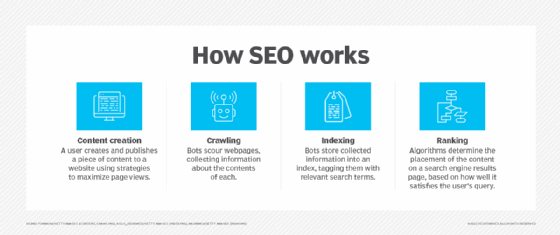white hat link building
What is white hat link building?
White hat link building is a search engine optimization (SEO) technique for increasing the number of high-quality backlinks to a webpage. The number and quality of backlinks can affect how a search engine such as Google or Bing ranks the webpage. Page ranking is one of the key factors that search engines consider when evaluating a webpage. The higher the page rank, the more likely the page will appear near the top of the search results.

Backlinks are links from other websites to the target webpage. Generally, the more sites that link to a webpage, the higher its page rank. However, this is true only if the links are coming from sites that the search engine considers to be high-quality domains.
The exact criteria search engines use to determine domain quality is not commonly shared, making SEO a challenge. It's widely believed that they weigh factors such as the website's relevancy to the target webpage, whether the link's placement appears natural or unnatural, and whether the referencing domain is considered trustworthy, as opposed to one that hosts a site such as a link farm or private blog network. Backlinks from less reputable sites will typically result in a lower page rank.
Because Google drives most search engine traffic, it sets the industry standard on link building and acceptable practices. Indeed, white hat link building is sometimes defined as the type of link building that adheres to Google's backlink guidelines. Google favors "organic" link building methods that enhance the user experience by boosting the quality of content and broadening its scope through relevant links.
White hat vs. black hat link building
White hat link building is often contrasted with black hat link building, another way to increase the number of backlinks to a webpage. Black hat link building takes a quantity-over-quality approach, focusing on short-term advantages.
With a black hat approach, website owners use methods not approved by Google. They might engage paid services such as link farms or private blog networks to generate backlinks in bulk or use automated link building tools to add comment links to multiple sites automatically.
Google and other search engine vendors frown upon such practices because they attempt to drive traffic to a site without adding value to the content or enhancing the user experience. Black hat tactics might also violate the search engine's terms of service. If the search engine suspects that a webpage used these tactics, it will penalize the page by reducing its ranking, sometimes for a long time.
Unlike black hat techniques, white hat link building aims to educate users and enhance their experience. It supports the idea that backlinks should be a natural addition to a webpage and make the content better and more complete. This organic type of link building is considered beneficial for the online community, which is why search engines reward this practice in their page rankings.
What is the white hat approach?
Black hat link building focuses on short-term gains, while white hat link building strives for long-term enhancements at both the page and website levels. The white hat approach can be labor-intensive and take longer to achieve, but the rewards are usually worth it.
There's no one strategy for increasing the number of backlinks to a webpage, and website owners often take multiple approaches. Here are some of the more common white hat link building strategies:
- Identify reputable third-party websites and offer to write high-quality guest posts that contain links back to their own webpages.
- Post high-quality, linkable content that contains valuable information such as exclusive research, survey results, case studies or the latest statistics on a timely subject.
- Find broken links, called link rot, on third-party websites that contain relevant content, and then contact the website owners to offer links to their own webpages as replacements.
- Leverage a service such as Help a Reporter Out, which enables them to connect with journalists who need expert input on specific topics in exchange for links back to the expert's webpage.
- Search for third-party websites that mention their brands, articles, websites or products in a positive light, and then contact the site owners about adding their own links to the site's content.
These are a few of the many ways website owners might apply white hat strategies. White hat link building is not the only SEO strategy for increasing traffic, but backlinks still play an important role in page ranking. Google and other search engines might not always rely as heavily on backlinks as they do now, but until that changes, backlinks should remain a core component of an SEO strategy.
Explore ways to improve your search engine ranking such as implementing processes for keyword research, on-page SEO practices and ensuring a page is mobile-friendly.
TechTarget is responding to readers' concerns, as well as profound cultural changes, when it comes to certain commonly used but potentially linguistically biased terms. In some cases, we are defaulting to industry-standard terminology that may be seen as linguistically biased in instances where we have not found a replacement term. However, we are actively seeking out and giving preference to terms that properly convey meaning and intent without the potential to perpetuate negative stereotypes.






